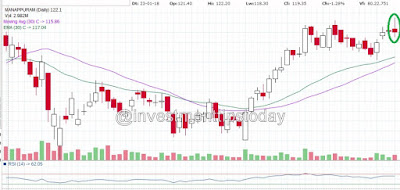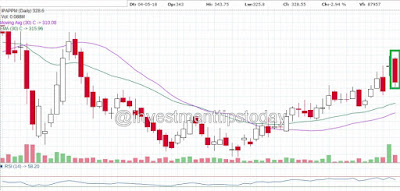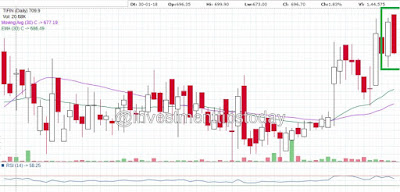I am investing in best mutual funds 2018 after doing a market research based on the present economy and performance of the mutual funds. I am also sharing with you about the mutual funds where I am investing this year. These will definitely give me a good return without taking much risk.
Bluechip companies are all large companies, with significant market share & leadership in their relevant industries. They already have shown positive growth, good credit ratings and better brand equity amongst the public. Investing in such companies brings relative reliability to your portfolio.
This fund provides the opportunities for long-term growth in capital through a dynamic management of investments in a diversified basket of equity stocks of companies whose market capitalization is equal to or more than the least market capitalised stock of S&P BSE 100 Index. This fund is suitable for those investors who are looking for medium to long-term perspective.
The minimum investment amount required for a lump sum is Rs.5000, while for SBI Bluechip fund SIPs the minimum amount to be invested is Rs.1000 only.
• Scheme Type: Open ended scheme
• Fund Manager: Sohini Andani
• Lock-In Period: 0
• Entry Load: Nil
• Exit Load: 1%
• NAV as on 10th May 2018 = Rs 38.6820
Growth (Present) %
• 1 Week: -0.31%
• 1 Month: - 0.52%
• 3 Months: - 2.77%
• 6 Months: - 2.80%
• 1 Year: - 11.46%
• 3 Years: - 41.55%
• 5 Years: - 124.82%
It is one of the best mutual funds for investment in India. This mutual fund is a regular performer in the mutual fund industry for a long time and has returned bigger profits to the investors. The main aim of this mutual fund is to provide capital growth and stable income so as to ensure financial soundness for the investors. This fund is best for the investors who are seeking financial stability and high growth of investments in the long-term.
The minimum investment amount required for a lump sum is Rs.5000, while for HDFC Balanced Fund SIPs the minimum amount to be invested is Rs.500 only.
• Scheme Type: Open ended scheme
• Fund Manager: Chirag Setalvad
• Lock-In Period: 0
• Entry Load: NIL
• Exit Load: Applicable
• NAV as on 10th May 2018 = Rs 149.2410
Growth (Present) %
• 1 Week: -0.25%
• 1 Month: - 0.16%
• 3 Months: - 0.06%
• 6 Months: - 0.61%
• 1 Year: - 10.18%
• 3 Years: - 42.21%
• 5 Years: - 137.45%
The main investment objective of this fund is to make steady return and appreciation of capital by investing in a mix of securities comprising of equity, equity related instruments and fixed income instruments. This fund was formerly known as “Reliance Regular Savings Fund - Balanced Option”. This fund is suitable for those who are seeking long-term capital growth and investment in equity.
Investment up to 50 percent of its assets in equities and equity-related securities and at least 25 percent of its assets in debt and money market instruments with an average maturity of 1 to 7 years.
Minimum Investment: Rs.500
• Scheme Type: Open ended scheme
• Entry Load: Nil
• Exit Load: 1%
• Fund Manager: Sanjay Parekh & Mr. Amit Tripathi
Growth (Present) %
• 1 Week: -
• 1 Month: - 0.9%
• 3 Months: - 0.5%
• 6 Months: - 2.8%
• 1 Year: - 11.9%
• 3 Years: - 12.2%
• 5 Years: - 16.8%
Generating regular long-term capital growth from a diversified portfolio of equity and equity-related securities is the main aim of this fund. It invests in equity and equity-linked instruments such that it features a high degree of growth with the possibility of producing high returns to those investing the Axis Long-Term Equity Fund scheme.
This fund is designed to offer subscribers with tax savings benefits under section 80C of the IT Act 1961.
• Scheme Type: Open ended scheme
• Fund Manager: Jinesh Gopani
• Entry Load: Nil
• Exit Load: Nil
• Minimum investment: Rs.500
• Lock-In Period: 3 Years
• NAV as on 16 May 2018: Rs 43.0670
Growth (Present) %
• 1 Week: - 0.67%
• 1 Month: - 1.48%
• 3 Months: - 6.13%
• 6 Months: - 10.12%
• 1 Year: - 18.63%
• 3 Years: - 12.17%
• 5 Years: - 22.73%
The main aim of this open-ended fund is to generate long-term capital appreciation from a diversified portfolio of mainly equity and equity-related securities, including equity derivatives. This fund mainly invests in the small-cap stocks (emerging companies). Additionally, this fund also invests in Foreign Securities. Emerging companies are the companies those businesses which are typically in the early stage of development. They have the perspective to grow their revenues and profits at a higher rate as compared to the broader market. There is no guarantee that the Scheme will be realised and the Scheme does not assure or promise any returns.
• Scheme Type: Open ended scheme
• Fund Manager: Soumendra Nath Lahir
• Entry Load: NIL
• Exit Load: NIL if purchased during the NFO period and during the 2 year period from the date of allotment.
• Minimum Investment: Rs.5000
• NAV as on 18 May 2018: Rs 27.52
Growth (Present) %
• 1 Week: - 0.77%
• 1 Month: - 1.75%
• 3 Months: - 1.03%
• 6 Months: - 3.94%
• 1 Year: - 18.31%
• 2 Year: 35.3%
• 3 Years: - 25.66%
It is an open-ended equity fund from Franklin Templeton Mutual Fund. As a predominant small-cap fund, it grasps a major portion of its investment in small caps and mid-caps along with a nominal portion into large caps. This makes appropriate for investors looking to boost of extraordinary returns generated by small caps. This fund is well known for strong investment processes, smart stock picking and sound risk management.
• Scheme Type: Open ended scheme
• Fund Manager: R Janakiraman
• Minimum Investment: Rs.5000
• Entry Load: 1%
• Exit Load: NIL
• NAV as on 18th May 2018 = Rs.60.00
Growth (Present) %
• 1 Month: - 0.9%
• 3 Months: - 0.5%
• 6 Months: - 1.9%
• 1 Year: - 12%
• 2 Year: 20.9%
• 3 Years: - 16%
• 5 Years: - 28.8%
These are the mutual funds that I am looking to invest in this year. After study and research, I have found that these funds will provide me greater return in the near future.
1. SBI Blue Chip Fund - Growth
Bluechip companies are all large companies, with significant market share & leadership in their relevant industries. They already have shown positive growth, good credit ratings and better brand equity amongst the public. Investing in such companies brings relative reliability to your portfolio.
This fund provides the opportunities for long-term growth in capital through a dynamic management of investments in a diversified basket of equity stocks of companies whose market capitalization is equal to or more than the least market capitalised stock of S&P BSE 100 Index. This fund is suitable for those investors who are looking for medium to long-term perspective.
The minimum investment amount required for a lump sum is Rs.5000, while for SBI Bluechip fund SIPs the minimum amount to be invested is Rs.1000 only.
• Scheme Type: Open ended scheme
• Fund Manager: Sohini Andani
• Lock-In Period: 0
• Entry Load: Nil
• Exit Load: 1%
• NAV as on 10th May 2018 = Rs 38.6820
Growth (Present) %
• 1 Week: -0.31%
• 1 Month: - 0.52%
• 3 Months: - 2.77%
• 6 Months: - 2.80%
• 1 Year: - 11.46%
• 3 Years: - 41.55%
• 5 Years: - 124.82%
2. HDFC Balanced Fund – Growth
It is one of the best mutual funds for investment in India. This mutual fund is a regular performer in the mutual fund industry for a long time and has returned bigger profits to the investors. The main aim of this mutual fund is to provide capital growth and stable income so as to ensure financial soundness for the investors. This fund is best for the investors who are seeking financial stability and high growth of investments in the long-term.
The minimum investment amount required for a lump sum is Rs.5000, while for HDFC Balanced Fund SIPs the minimum amount to be invested is Rs.500 only.
• Scheme Type: Open ended scheme
• Fund Manager: Chirag Setalvad
• Lock-In Period: 0
• Entry Load: NIL
• Exit Load: Applicable
• NAV as on 10th May 2018 = Rs 149.2410
Growth (Present) %
• 1 Week: -0.25%
• 1 Month: - 0.16%
• 3 Months: - 0.06%
• 6 Months: - 0.61%
• 1 Year: - 10.18%
• 3 Years: - 42.21%
• 5 Years: - 137.45%
3. Reliance Equity Hybrid Fund-Direct Plan – Growth
The main investment objective of this fund is to make steady return and appreciation of capital by investing in a mix of securities comprising of equity, equity related instruments and fixed income instruments. This fund was formerly known as “Reliance Regular Savings Fund - Balanced Option”. This fund is suitable for those who are seeking long-term capital growth and investment in equity.
Investment up to 50 percent of its assets in equities and equity-related securities and at least 25 percent of its assets in debt and money market instruments with an average maturity of 1 to 7 years.
Minimum Investment: Rs.500
• Scheme Type: Open ended scheme
• Entry Load: Nil
• Exit Load: 1%
• Fund Manager: Sanjay Parekh & Mr. Amit Tripathi
Growth (Present) %
• 1 Week: -
• 1 Month: - 0.9%
• 3 Months: - 0.5%
• 6 Months: - 2.8%
• 1 Year: - 11.9%
• 3 Years: - 12.2%
• 5 Years: - 16.8%
4. Axis Long Term Equity Fund (Growth)
Generating regular long-term capital growth from a diversified portfolio of equity and equity-related securities is the main aim of this fund. It invests in equity and equity-linked instruments such that it features a high degree of growth with the possibility of producing high returns to those investing the Axis Long-Term Equity Fund scheme.
This fund is designed to offer subscribers with tax savings benefits under section 80C of the IT Act 1961.
• Scheme Type: Open ended scheme
• Fund Manager: Jinesh Gopani
• Entry Load: Nil
• Exit Load: Nil
• Minimum investment: Rs.500
• Lock-In Period: 3 Years
• NAV as on 16 May 2018: Rs 43.0670
Growth (Present) %
• 1 Week: - 0.67%
• 1 Month: - 1.48%
• 3 Months: - 6.13%
• 6 Months: - 10.12%
• 1 Year: - 18.63%
• 3 Years: - 12.17%
• 5 Years: - 22.73%
5. L&T Emerging Businesses Fund – Growth
The main aim of this open-ended fund is to generate long-term capital appreciation from a diversified portfolio of mainly equity and equity-related securities, including equity derivatives. This fund mainly invests in the small-cap stocks (emerging companies). Additionally, this fund also invests in Foreign Securities. Emerging companies are the companies those businesses which are typically in the early stage of development. They have the perspective to grow their revenues and profits at a higher rate as compared to the broader market. There is no guarantee that the Scheme will be realised and the Scheme does not assure or promise any returns.
• Scheme Type: Open ended scheme
• Fund Manager: Soumendra Nath Lahir
• Entry Load: NIL
• Exit Load: NIL if purchased during the NFO period and during the 2 year period from the date of allotment.
• Minimum Investment: Rs.5000
• NAV as on 18 May 2018: Rs 27.52
Growth (Present) %
• 1 Week: - 0.77%
• 1 Month: - 1.75%
• 3 Months: - 1.03%
• 6 Months: - 3.94%
• 1 Year: - 18.31%
• 2 Year: 35.3%
• 3 Years: - 25.66%
6. Franklin India Smaller Companies Fund - Growth
It is an open-ended equity fund from Franklin Templeton Mutual Fund. As a predominant small-cap fund, it grasps a major portion of its investment in small caps and mid-caps along with a nominal portion into large caps. This makes appropriate for investors looking to boost of extraordinary returns generated by small caps. This fund is well known for strong investment processes, smart stock picking and sound risk management.
• Scheme Type: Open ended scheme
• Fund Manager: R Janakiraman
• Minimum Investment: Rs.5000
• Entry Load: 1%
• Exit Load: NIL
• NAV as on 18th May 2018 = Rs.60.00
Growth (Present) %
• 1 Month: - 0.9%
• 3 Months: - 0.5%
• 6 Months: - 1.9%
• 1 Year: - 12%
• 2 Year: 20.9%
• 3 Years: - 16%
• 5 Years: - 28.8%
These are the mutual funds that I am looking to invest in this year. After study and research, I have found that these funds will provide me greater return in the near future.






